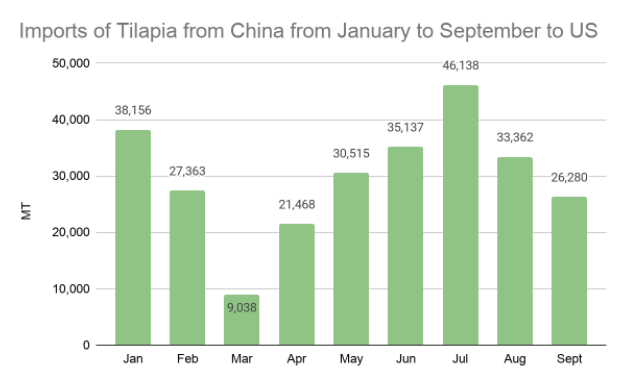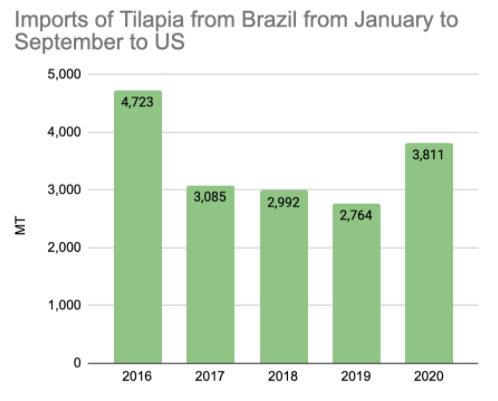Tariffs back on Chinese Tilapia for the US, and Brazil eyeing on opportunities
Chinese Tilapia in the US market
The US is the world’s largest tilapia market in the world. The competition with other seafood products has been decreasing its consumption over the years, but it still represented more than half of the world’s imports for the segment in 2018 and 2019. The largest supplier of tilapias to the US is China, which nearly one-third of its production is targeted to the American market.
- The trade war between the two countries has also raised the US tariffs on frozen tilapia fillets by 25% on May 9, 2019.This measure resulted in a 25% reduction in volume in imports in 2019 of Chinese tilapia in comparison with 2018. During 2019, the Chinese tilapia saw a reduction in price which attracted new importers from EU countries, where it saw an increase of 22% in 2019.
- By 2020, with the pandemic, the sector was hit with difficulties in production due to reduced personnel, lockdowns, feed shortages, limitations to the processing activities, and a reduction of consumption due to lockdowns and decrease in sales to the restaurant sector.
- In April 2020, the US and the Chinese government have signed the Phase One agreement where it stipulated a removal of the tariffs to some of the seafood products in which “tilapia, frozen, each weighing not more than 115 grams” was included and exempted until August 7th. During this period the exports to the US have regained momentum and reached a high in July with 46K MT. However, in August the US Trade Representative (USTR) has released the list of products that will receive a further extension on tariffs exclusions and tilapia is no longer on the list and it is now under the 25% tariffs once again, and exports have already subsided in August and September.
- The Chinese tilapia suppliers have already been preparing since last years’ first announcement on the harsher tariffs on Chinese products by the US, and plan to reduce their exports by 10% and focus on developing their domestic markets.

Source: Modified from NOAA.
Opportunity for Brazilian tilapia
The news on the US tariffs back to 25% to the Chinese tilapia is seen as an opportunity to the Brazilian tilapia producers. The US market has been dominated by the Chinese frozen tilapia fillets especially due to its highly competitive price, but Brazil can offer fresh tilapia. The fresh tilapia fillets can be available in the American market within just 48 hours from slaughter. The Brazilian tilapia production achieved 432K MT in 2019 with a growth rate of 8% compared to 2018, and it is the 4th in world production with a vast growth potential due to abundant fresh water in the country which can be used for its production. President of Peixe BR says that “in 20 years Brazil will be the biggest tilapia producer in the world” and could become a big exporter in coming years.

Source: Modified from NOAA.
Sources:
NOAA. Cumulative Trade Data by Country/Association.
Undercurrentnews, “Tilapia market sees US demand revival after tariff exemption”.
FAO. “Tilapia exports hit hard by COVID-19”.
TradeMap. Imports and Exports.
Aquaculture North America. “Chinese tilapia exports hit hard by Covid-19“.
Seafood Source. “USTR extends tariff exclusions for some seafood products, others will face tariffs again“
Sintracoop. “Cooperativa inicia exportação de tilápia resfriada aos EUA“.
Diario do Comerio. “Tilápia se destaca e produção sobe 4,9%".
Agrolink. "Em 20 anos Brasil será maior produtor de tilápia"


